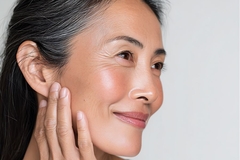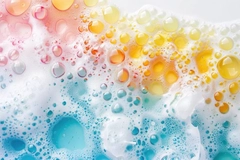Beauty-from-within: Holistic health trends and supplement combinations
Multifunctional trends in makeup and skin care are a rising trend in the beauty sector as customers expect multiple skin benefits from products. Similarly, this multifunctional expectation is turning to nutrition, leading brands and ingredient suppliers to study the way certain nutrients may lead to holistic health and beauty benefits.
Personal Care Insights interviewed two industry executives about their perspectives on consumer trends in the beauty-from-within market, plus product clinical trials for supplements designed to meet specific beauty demands.
“In the nutricosmetics space, skin health is a top priority for consumers as people are becoming more aware of the connection between skin health and nutrition,” says Jessica Arnaly, a senior marketing and business development manager at Balchem Human Nutrition & Health.
“For example, the trend of glass skin and glowing skin has taken the beauty world by storm. The goal is a dewy, luminous finish that appears almost translucent. This trend underscores the importance of a healthy skin barrier and has inspired a broader movement toward achieving naturally glowing skin through consistent skin care practices and healthy lifestyle choices.”
Supplementing consumer beauty trends
The link between skin health and health habits, such as diet and nutrition, is well established. Researchers have found connections between skin disease and foods like milk, sugar and white bread, and, more recently, dermatologists have linked high alcohol consumption to acne, rosacea and psoriasis.
On the proactive side of skin health, dermatologists have promoted diets based on whole foods, mainly plant-based foods, that balance nutrients to support healthy and balanced skin. Seeking these proactive elements, some consumers are turning to nutritional supplements in the hopes of addressing specific beauty needs like skin elasticity, hydration and luminosity.
“In the current market context, consumers are less focused on avoiding ‘negatives’ such as skin aging, wrinkles or blemishes, with the emphasis instead on pursuing a natural glow through a healthy lifestyle,” says Bioiberica marketing director Antonio Vendrell.
Arnaly confirms this consumer focus on pursuing holistic well-being drives companies to innovate the foundational understanding of nutrition. “In recent years, we’ve seen consumers worldwide taking a more holistic approach to well-being, and so we expect brands to explore synergistic formulations that combine new and long-standing nutricosmetic ingredients,” says Arnaly.
“For example, probiotics and other gut health supplements are gaining interest for their potential benefits in skin care.”
Focus on functional foods
Though supplement brands are seeing new and increased market interest, Vendrell sees the nutricosmetic market as being fairly consistent. These consumers are looking for “efficacy, proactivity and convenience,” he says. 
This may be prompting a turning tide in the personal care market, with more beauty consumers turning away from topical products to nutritional supplements that may address the same issues.
“We can see this in the market reports that topical cosmetics usage has decreased by a third over the past five years, with 66% of consumers also stating they recognize the link between skin health and whole-body well-being,” adds Vendrell.
This shift is prompting companies to pursue innovations in nutritional supplement formats like “functional foods,” novel foods with added ingredients or substances that purport health-enhancing — or possibly disease-preventing — benefits.
He says that a rising trend indicates customers are reaching for food and beverages that boast added nutritional claims. “Once upon a time, an easy-to-swallow skin health tablet might have been considered the height of convenience, but today, fun and functional foods, such as fortified teas or soft drinks, are far more likely to capture consumers’ attention.”
Balchem highlights its product line of protein and collagen crisps called Z-Crisps. This ingredient is designed to enhance nutrition in other food products like candy bars, granola bars, trail mixes and other snacks. The crisps look like little cereal balls and can add whey or plant protein to food, says Balchem.
“These crisps uniquely combine pea protein and collagen, creating a formulation ideal for multifunctional, high-protein snack bars,” says Arnaly.
“This combination reflects a strategic effort to address both the sensory and health-related preferences of today’s health-conscious consumers.”
Nutritional combinations
Beauty supplement launches are on the rise, with a 21% average annual growth rate since October 2019 through September 2024, with nearly half of the launches occurring in Europe, reports Innova Market Insights. As these launches increase, nutritional companies are facing fierce competition among the standard supplement offerings, such as collagen.
“The beauty-from-within space has by far been dominated by collagen type I, leading to what some call the ‘collagen boom.’ Collagen supplements are beneficial for improving skin elasticity and firmness, but the market is getting crowded, with over 3,000 new collagen supplement products launched each year globally,” says Arnaly.
To stand out in the crowded collagen arena, Balchem is promoting a combined collagen and methylsulfonylmethane (MSM) formulation that purports to target skin health. MSM is an organic sulfur that is naturally produced in the body and also found in small amounts in fruit, vegetables, grains and milk. As a nutritional supplement, MSM is primarily utilized as an anti-inflammatory ingredient that could target joint pain.
Companies like Balchem are now exploring MSM for its potential skin and hair-strengthening benefits. The format of MSM it uses is called OptiMSM.
“MSM is a source of sulfur, an essential structural component of the building blocks of skin and hair, and has demonstrated benefits for the skin, including the reduction of the appearance of fine lines and wrinkles,” says Arnaly. 
In a recent white paper titled “Boosting Collagen Formulations: The Power of OptiMSM,” Balchem detailed clinical trial results for the collagen and MSM formulation. The double-blind, placebo-controlled trial split 109 female participants aged 40 to 65 into four groups. The first group received a placebo, group two received a high dose of just collagen, group three received a low dose of collagen and MSM, and the final group received a high dose of collagen and MSM.
The results indicate that overall skin thickness and hydration improved among the groups who took the low-dose and high-dose combined collagen and MSM. The groups also saw a decrease in skin roughness and texture, according to the paper.
“This powerful combination provides superior results,” says Arnaly.
Bioiberica has similarly focused on novel ingredients for beauty supplement consumers.
“Our answer to these market trends is Dermial, the first hyaluronic acid (HA) matrix ingredient developed to support skin and beauty through the power of three naturally occurring components: a high concentration of HA, dermatan sulfate and collagen,” says Vendrell.
Dermial’s formulation is 60-75% HA, which is a naturally occurring component that makes skin look hydrated. HA can be used as a topical product in skin care to reduce the appearance of wrinkles and it is also used as a dietary supplement to reduce arthritis pain and improve skin.
Bioiberica conducted a clinical trial of Dermial with 60 participants — women between 35 and 65 years old — half of whom took 60 milligrams of Dermial daily for 12 weeks and the other half a placebo.
“The trial revealed that the daily supplement had a unique ‘glow’ effect on the skin — increasing skin brightness by 20% at six weeks and almost 34% at twelve weeks,” says Vendrell. Other results included wrinkle reduction, he says.
Despite an increasingly saturated supplement market, Vendrell strikes an optimistic tone about the outlook of the beauty-from-within space and the connection to market consumers. Following consumer desires while staying consistent may be the key to success.
“In contrast to other beauty segments where there is a near constant trend-turnover, the essential themes shaping the beauty-from-within space remain fairly consistent,” says Vendrell. “What does shift, however, is how these themes manifest in the consumer imagination.”














